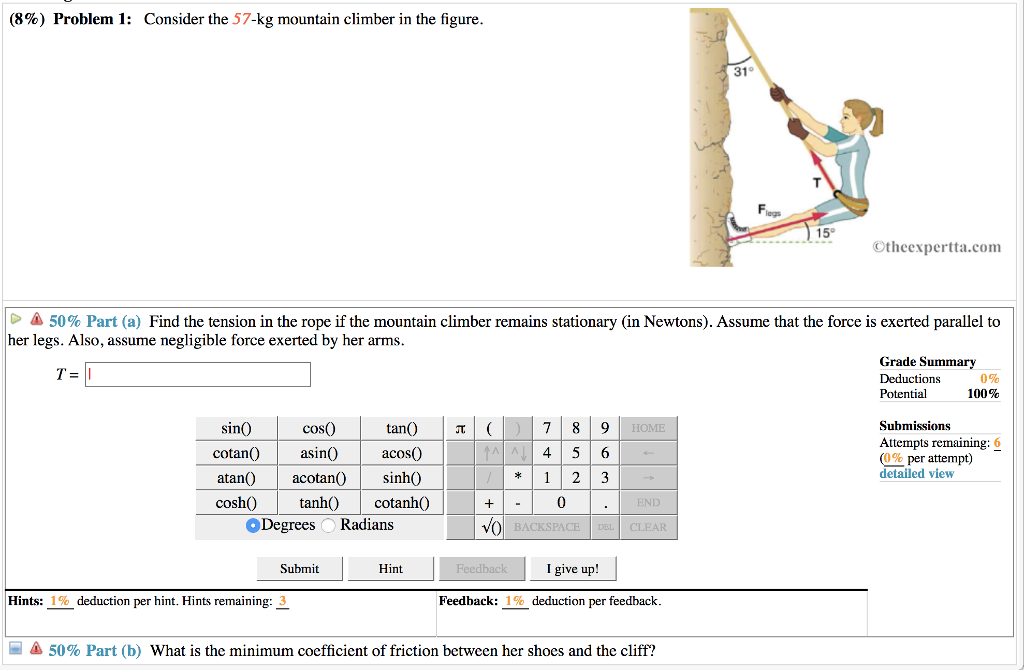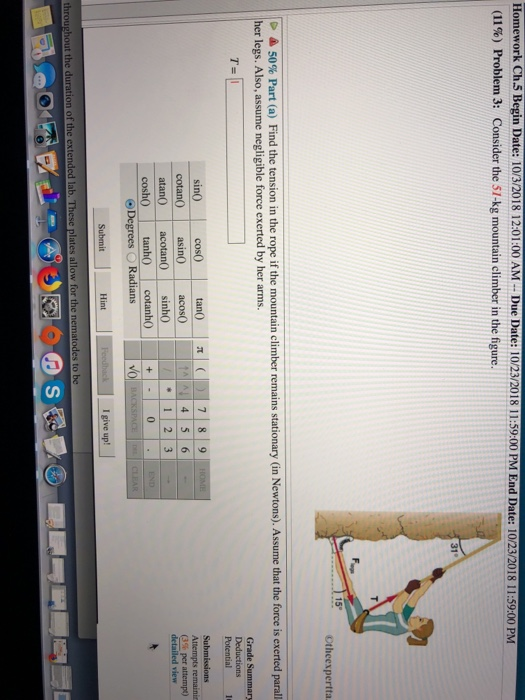Consider the 51 Kg Mountain Climber in the Figure
12-41 a climber with a weight of 5338 mathrmN is held by a. Also assume negligible force exerted by her arms.

Solved Ipad 10 39 89 Ust35nc Theexpertta Com Problem 4 Chegg Com
Randomized Variables m 64 kg d 076 cm l 31 m By how much does the mountain climber stretch her rope in centimeters when she hangs 31 m below a rock outcropping.

. Consider the 520-kg mountain climber in Figure 522. A Find the tension in the rope and the force that the mountain climber must exert with her feet on the vertical rock face to remain stationary. A Find the tension in the rope and the force that the mountain climber must exert with her feet on the vertical rock face to remain stationary.
A Find the tension in the rope and the force that the mountain climber must exert with her feet on the vertical rock face to remain stationary. Assume that the force is exerted parallel to her legs. Also assume negligible force exerted by her arms.
Up to 256 cash back Consider the 510-kg mountain climber in the figure. A Find the tension in the rope and the force that the mountain climber must exert with her feet on the vertical rock face to remain stationary. A Find the tension in the rope and the force that the mountain climber must exert with her feet on the vertical rock face to remain stationary.
Also assume negligible force exerted by her arms. In the rope and b the force that the. Consider the 520-kg mountain climber in the figure to the right.
A 52 Kg mountain climber is suspended from a cliff by a rope. Two identical 150 kg balls each 250 cm in diameter are suspended by two 350 cm wires as shown in the. So the force of tension upwards is going to equal the force of gravity downwards and so that will give us f in our formula for delta l.
Consider the 500-kg mountain climber in. Consider the 520-kg mountain climber shown below. To get up on the roof a person mass 700 kg places a 600-m aluminum ladder mass 100 kg against the house on a concrete pad with the base of the ladder 200 m from the house.
Assume that the force is exerted parallel to her legs. A Find the tension in the rope and the force that the mountain climber must exert. Physics College Physics Consider the 520-kg mountain climber in Figure 522.
Assume that the force is exerted parallel to her legs. Consider the 520-kg mountain climber in Figure 522. Also assume negligible force exerted by her arms.
What average mechanical power in W must a 615 kg mountain climber generate to climb to the summit of a hill of height 345 m in 490 min. Consider the 520-kg mountain climber in Figure 520. Find the climbers elevation above sea level after meeting the other climber.
A Find the tension in the rope and the force that the mountain climber must exert with her feet on the vertical rock face to remain stationary. A Find the tension in the rope and the force that the mountain climber must exert with her feet on the vertical rock face to remain stationary. Mountain climber must exert with her feet.
Consider the 520 -kg mountain climber in Figure 522 a Find the tension i 0441 In Fig. Assume that the force is exerted parallel to her legs. With her feet on the vertical rock face.
Also assume negligible force exerted by her arms. Also assume negligible force exerted by her arms. Find a the tension.
Assume that the force is exerted parallel to her legs. A mountain climber ascends a mountain to its peak. Assume that the force is exerted parallel to her legs.
Consider the 520-kg mountain climber in Figure 522. Also assume negligible force exerted by her arms. Assume that the force is exerted parallel to her legs.
Consider the 520-kg mountain climber in Figure 520. A climber is hanging by her rope and we want to find out how much does the nylon stretch. Find a the tension in the rope and b the force that the mountain climber must exert with her feet on the vertical rock face to remain stationary.
Assume that the force is exerted. On the vertical rock face to remain. A Find the tension in the rope and the force that the mountain climber must exert with her feet on the vertical rock face to remain stationary.
A Find the tension in the rope and the force that the mountain climber must exert with her feet on the vertical rock face to remain stationary. Assume that the force is exerted parallel to her legs. Assume the Youngs modulus of the rope is 5 x 109 Nm2 Grade Summary Deductions 100.
Up to 256 cash back 28 Nov 2020 Consider the 510-kg mountain climber in the figure. Consider the 520-kg mountain climber shown below. The climber then descends 200 ft to meet a fellow climber.
Consider the 650-kg ice skater being pushed by two others shown below. Assume that the force is exerted parallel to her legs. A Find the tension in the rope and the force that the mountain climber must exert with her feet on the vertical rock face to remain stationary.
Assume that the force is exerted parallel to her legs. Also assume negligible force exerted by her arms. We know that the climber is 650 kilograms.
Also assume negligible force exerted by her arms. A Find the tension in the rope and the force that the mountain climber must exert with her feet on the vertical rock face to remain stationary. The peak is 12740 ft above sea level.
The ladder rests against a plastic rain gutter which we can assume to be frictionless. The figure to the right. A Find the tension in the rope and the force that the mountain climber must exert with her feet on th.
Also assume negligible force exerted by her arms. But before we get ahead of ourselves lets write down all the data were given. Consider the 520-kg mountain climber shown below.
Also assume negligible force exerted by her arms. Consider the 520-kg mountain climber in Figure 520. Assume that the force is exerted parallel to her legs.
Assume that the force is exerted parallel to her legs. Also assume negligible force exerted by her arms. Given a few bits of information the angle formed by the rope to the climber is 31 degrees.
Suppose a kg mountain climber has a 076 cm diameter nylon rope. The angle of the climbers legs is 15 degrees north of horizontal. Consider the 520-kg mountain climber in Figure 522.
Due to inefficiencies in converting chemical energy to mechanical energy the amount calculated here is only a fraction of the power that must be produced by the climbers body. Assume that the force is exerted parallel to her legs. Also assume negligible force exerted by her arms.
A Find the tension in the rope and the force that the mountain climber must exert with her feet on the vertical rock face to remain stationary. Assume that the force is exerted parallel to her legs. Consider the 520 -kg mountain climber in Figure 522 a Find the tension in the rope and the force that the mountain climber must exert with her feet on the vertical rock face to remain stationary.
The center of mass of the ladder is 200 m from the bottom.

Solved 8 Problem 1 Consider The 57 Kg Mountain Climber Chegg Com

Openstax College Physics Solution Chapter 5 Problem 17 Problems Exercises Openstax College Physics Answers

Solved 8 Problem 12 Consider The 51 Kg Mountain Climber Chegg Com

Solved Homework Ch 5 Begin Date 10 3 2018 12 01 00 Am Due Chegg Com
No comments for "Consider the 51 Kg Mountain Climber in the Figure"
Post a Comment